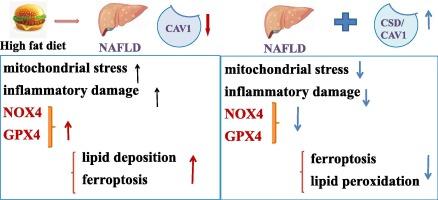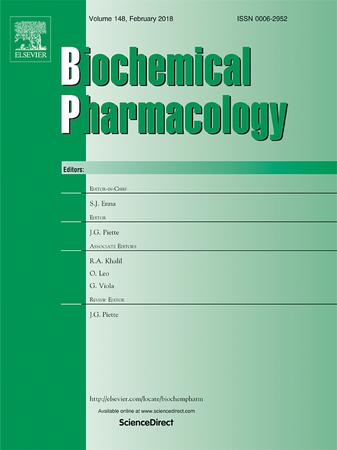Caveolin-1通过NOX4/ROS/GPX4途径抑制铁跃迁,从而改善非酒精性脂肪肝的肝损伤。
IF 5.3
2区 医学
Q1 PHARMACOLOGY & PHARMACY
引用次数: 0
摘要
非酒精性脂肪肝(NAFLD)是全球发病率最高的慢性肝病,其发病机制复杂且存在争议。Caveolin-1(CAV1)是肝功能的重要调节因子,可通过清除活性氧(ROS)减轻肝损伤。有证据表明,NOX4 是产生 ROS 的一个来源,氧化应激和铁变态反应密切相关,两者都参与了非酒精性脂肪肝的发生和发展。然而,CAV1是否通过NOX4/ROS/GPX4途径减轻高脂饮食引起的非酒精性脂肪肝的肝损伤仍不清楚。通过给小鼠喂食高脂肪饮食 16 周,建立了体内脂肪肝模型。此外,我们还采用体外培养法,将 AML-12 细胞与游离脂肪酸孵育 24 小时,建立了体外脂肪肝模型。在我们的研究中观察到,高脂饮食会诱导线粒体损伤,加重非酒精性脂肪肝的氧化应激。这种饮食还阻碍了 GPX4 的表达,导致铁变态反应和脂质积累的升级。为了抵消这些影响,给小鼠腹腔注射 CSD 肽可减轻高脂饮食引起的肝线粒体损伤和铁蛋白沉积。同样,过量表达 CAV1 可增加 GPX4 的表达,降低 ROS 介导的铁蜕变水平,从而缓解疾病的进展。然而,CAV1 对 GPX4 介导的铁蜕变和脂质沉积的影响可被 CAV1 小干扰 RNA(SiRNA)逆转。最后,NOX4 抑制剂(GLX351322)可增加 CAV1 siRNA 介导的 GPX4 表达,并降低 ROS 介导的铁蛋白沉积水平。这些发现提示了CAV1在非酒精性脂肪肝中对高脂饮食诱导的肝毒性的保护作用的潜在机制,为CAV1、GPX4和铁蛋白沉积在肝脏病理学中的相互作用提供了新的线索。本文章由计算机程序翻译,如有差异,请以英文原文为准。

Caveolin-1 ameliorates hepatic injury in non-alcoholic fatty liver disease by inhibiting ferroptosis via the NOX4/ROS/GPX4 pathway
Nonalcoholic fatty liver disease (NAFLD) is the most prevalent chronic liver disease globally, with a complex and contentious pathogenesis. Caveolin-1 (CAV1) is an important regulator of liver function and can mitigate liver injury by scavenging reactive oxygen species (ROS). Evidence suggests that NOX4 is a source of ROS production, that oxidative stress and ferroptosis are closely related, and that both are involved in the onset and progression of NAFLD. However, whether CAV1 attenuates liver injury in NAFLD caused by high-fat diet via the NOX4/ROS/GPX4 pathway remains unclear. An in vivo fatty liver model was established by feeding mice with a high-fat diet for 16 weeks. In addition, an in vitro fatty liver model was established by incubating AML-12 cells with free fatty acids for 24 h using an in vitro culture method. In our study, it was observed that a high-fat diet induces mitochondrial damage and worsens oxidative stress in NAFLD. This diet also hinders GPX4 expression, leading to an escalation of ferroptosis and lipid accumulation. To counteract these effects, intraperitoneal administration of CSD peptide in mice attenuated the high-fat diet-induced liver mitochondrial damage and ferroptosis. Likewise, overexpression of CAV1 resulted in an increase in GPX4 expression and a reduction in levels of ROS-mediated iron metamorphosis, thus mitigating the progression of the disease. However, the effects of CAV1 on GPX4-mediated ferroptosis and lipid deposition could be reversed by CAV1 small interfering RNA (SiRNA). Finally, NOX4 inhibitor (GLX351322) treatment increased CAV1 siRNA-mediated GPX4 expression and decreased the level of ROS-mediated ferroptosis. These findings suggest a potential mechanism underlying the protective role of CAV1 against high-fat diet-induced hepatotoxicity in NAFLD, shedding new light on the interplay between CAV1, GPX4, and ferroptosis in liver pathology.
求助全文
通过发布文献求助,成功后即可免费获取论文全文。
去求助
来源期刊

Biochemical pharmacology
医学-药学
CiteScore
10.30
自引率
1.70%
发文量
420
审稿时长
17 days
期刊介绍:
Biochemical Pharmacology publishes original research findings, Commentaries and review articles related to the elucidation of cellular and tissue function(s) at the biochemical and molecular levels, the modification of cellular phenotype(s) by genetic, transcriptional/translational or drug/compound-induced modifications, as well as the pharmacodynamics and pharmacokinetics of xenobiotics and drugs, the latter including both small molecules and biologics.
The journal''s target audience includes scientists engaged in the identification and study of the mechanisms of action of xenobiotics, biologics and drugs and in the drug discovery and development process.
All areas of cellular biology and cellular, tissue/organ and whole animal pharmacology fall within the scope of the journal. Drug classes covered include anti-infectives, anti-inflammatory agents, chemotherapeutics, cardiovascular, endocrinological, immunological, metabolic, neurological and psychiatric drugs, as well as research on drug metabolism and kinetics. While medicinal chemistry is a topic of complimentary interest, manuscripts in this area must contain sufficient biological data to characterize pharmacologically the compounds reported. Submissions describing work focused predominately on chemical synthesis and molecular modeling will not be considered for review.
While particular emphasis is placed on reporting the results of molecular and biochemical studies, research involving the use of tissue and animal models of human pathophysiology and toxicology is of interest to the extent that it helps define drug mechanisms of action, safety and efficacy.
 求助内容:
求助内容: 应助结果提醒方式:
应助结果提醒方式:


